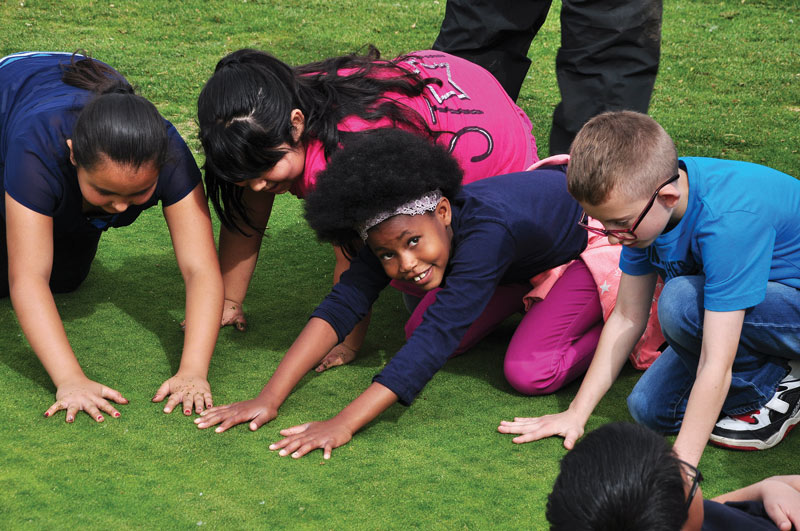
Third-graders from Taylor Elementary School in Colorado Springs, Colo., get up-close and hands-on with the outdoors during a First Green field trip at Patty Jewett Golf Course last spring. Photo by David Phipps
Last May, one of the oldest golf courses west of the Mississippi became the first golf course in Colorado to host a First Green field trip. Patty Jewett Golf Course, nestled at the foot of Pikes Peak in Colorado Springs, Colo., welcomed two third-grade classes from Taylor Elementary School, which is located adjacent to the golf course. Thirty-five third graders — most of whom were stepping onto a golf course for the first time — arrived eager to learn and explore. The team on hand for the event consisted of Patty Jewett GC superintendent Jeff Wichman (a 13-year GCSAA member) and his staff, PGA professional Bill Martin, pro shop co-owner Jeff Martin, and restaurant manager Michael Head. Also on-site to help out was David Phipps, GCSAA’s Northwest field staff representative.
First Green is an innovative youth education outreach program that turns golf courses into environmental learning labs and incorporates STEM education (science, technology, engineering and math). We planned the day’s activities with staff from First Green and with Taylor Elementary third-grade teachers Michele Cheesman and Natalie Porter. The teachers ultimately decided on First Green’s lesson plan for calculating areas, which meets the Colorado academic standards for third grade.
We set up three stations on the practice putting green and divided the students into three groups. The first station was the math lab, where Patty Jewett staff had plotted out a rectangle for the students to measure with a tape measure. They recorded the measurements to find the area of the rectangle, and we then explained that superintendents need to know how to determine area so we can order the correct quantities of supplies for the golf course. We also took a core sample out of the green to show students how a green is constructed.
At the second station, the golf pros taught the students how to line up a putt and gave them a quick lesson before setting them free to putt. (This station was popular!) For the final station, golf course staff brought up a few mowers and a roller and let students explore the equipment and see the roller in action. The staff also laid out clippings from a green and fairway so the students could check out the different textures.
Each station was 20 minutes, and because we stayed on schedule, we used the extra time to trek to Patty Jewett’s irrigation lake and pump house. The irrigation lake is a reclaimed water source that was added in 2010 to take some pressure off our non-potable system at night. In 2000, the golf course collaborated with Taylor Elementary School to install a sub-meter on the non-potable system to allow use of the system’s treated wastewater for irrigating the school’s landscape along with a new park. A separate irrigation system and water for the park would have been cost-prohibitive, so without this configuration, the park these students love to play in today wouldn’t exist.
The day ended back at the clubhouse, where the restaurant staff had snacks ready for our guests (the highlight of any field trip!). The outing lasted about two hours, and the students took away fun memories (as evidenced in the thank-you notes we later received), awareness of golf courses’ environmental stewardship, and the knowledge that if they keep learning science and math skills, they could one day be so lucky as to work at a place like a golf course.
I encourage all superintendents to get involved with First Green and open up their courses as learning labs to help more students fall in love with both STEM learning and with being out on a golf course. Our field trip didn’t take much effort to pull together — the hardest part was simply deciding to do it. The First Green website offers extensive resources, including lesson plans and helpful videos, and its staff can also facilitate connections between golf courses and local science/horticulture teachers.
As superintendents, we evaluate our courses daily, and we tend to slip into a routine and overlook the little things that make working outdoors great. Watching third-graders point out things and get excited about the golf course was eye-opening, and it brought me back to when I first started in this profession and everything was new. We hope to host another field trip at Patty Jewett this spring.
Patrick Gentile, CGCS, is the golf division superintendent for the city of Colorado Springs, where he has worked for 23 years. A 25-year member of GCSAA, he oversees the operations and maintenance of the city’s two golf courses, Patty Jewett and Valley Hi.